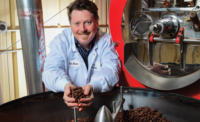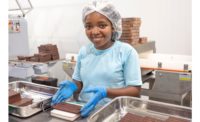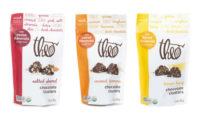Peter Kelsey wasn’t thrilled with what he saw.
A baker by trade and a bicyclist by sport, Kelsey, of Minneapolis, Minn., stood in the energy bar aisle of an outdoor recreation retailer in 2013, searching for something appetizing he could take with him on the road.
“I didn’t really see anything I wanted to eat because of what they all taste like,” he says. “As a person who has been in the food business since I was 15, I was just thinking, ‘what would I make a bar out of?’”
Recalling the snacks he packed for the hiking and canoe trips of his earlier years, Kelsey thought dark chocolate could be a delicious, effective vehicle for energy-giving ingredients.
He was right. After two years of education and experimentation, Kelsey launched K’ul Chocolate in Minneapolis’ Seward neighborhood. K’ul, pronounced “k’ool,” is the Mayan word for energy — the embodiment of Kelsey’s mission and a fitting tribute to one of the first civilizations to make and consume chocolate for its nutritional benefits.
Kelsey’s flagship creation, the Endurance bar, is made with 70-percent dark chocolate and cranberries, for taste and chew; guarana, for a caffeine boost; and pumpkin seeds coated with algae protein for extra substance. The vegan, gluten-free and non-GMO bar also comes sealed in a thermoform pouch that protects against leakage if it melts in the sun or in the pocket of a bicycling jersey.
An avid outdoorsman, Kelsey can attest to the bar’s efficacy.
“On (a recent) canoe trip, we had a couple of afternoons where it got rainy, it was the end of the day, we have to find a campsite, we’re tired, and we ate Endurance bars. They really work,” he says.
Incorporating tasty, potent ingredients is only half the equation, however. A self-described “do-it-yourselfer,” Kelsey wasn’t interested in buying and using chocolate from standard suppliers. He instead traveled to Costa Rica, Mexico, Ecuador, Peru, Brazil and Haiti in search of quality cocoa beans that could be sorted, winnowed and ground at the Minneapolis production facility.
Forming direct relationships with farmers aligns with Kelsey’s main objective: creating the best-tasting chocolate and energy bars. But there is an added bonus, he says.
“The money goes directly to the farm, and that’s a good thing, too, if you can do it,” he says.
Since its inception in August 2015, K’ul launched three more 70-percent dark chocolate bars that were created with active consumers in mind. They are:
- Stamina: Cranberries, cherries, pomegranate, raspberries and maca root.
- Power: Peanuts, currants and protein.
- Electrobar: Bananas, evaporated coconut water, toasted coconut, Cyprus sea salt and electrolytes.
Kelsey says the bars have seen success among fitness- and outdoors-based consumers in need of high-calorie, portable and nutritious items to power through long bicycle rides, canoe trips or marathons. But the bars haven’t necessarily translated to more general markets.
As a result, K’ul last month launched a series of single-origin bars using high-quality cacao and cocoa from several regions. They include:
- Maranon White Bean from Maranon River, Peru. This cacao has strong floral notes, as well as notes of orange and butterscotch.
- Cocoa from the Kafupbo farmer-owned cooperative in Petit Bourg de Borgnes, Haiti. This cocoa has notes of red fruit, jasmine and licorice.
- Forastero cocoa from the Fazenda Camboa farm in Bahia, Brazil. This cocoa has notes of malt, grapes and brown sugar.
- Heirloom cacao from the Hacienda Limon farm in Los Rios, Ecuador. This cacao has notes of brown sugar, citrus and butter.
Kelsey says the single-origin bars are gaining traction, but communicating dark chocolate’s positive attributes remains a challenge.
“People are willing to eat sweets and take the hit on their calorie count because they are enjoyable, but they’re not ready to completely look at chocolate as food, which is what I’ve been trying to present in the energy bar,” he says. “It’s important to understand that dark chocolate is not going to ruin your diet or be detrimental to your health.”
Kelsey says he’s testing and experimenting with new concepts, but creating high-quality chocolate is his priority.
“I would prefer to really focus on making great farm-to-bar chocolate and hoping that it’s received well,” he says.












